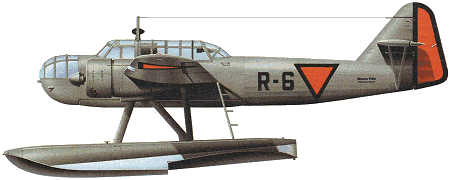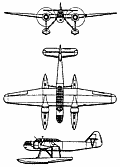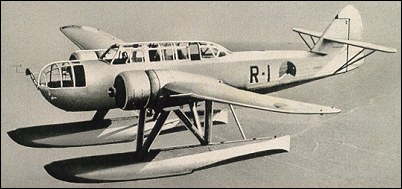|
| Designed to Netherlands naval air service specifications for a torpedo-bomber/reconnaissance aircraft suitable for home and the Netherlands East Indies service, the Fokker T.VIII-W floatplane was built in three versions: the T.VIII-Wg of mixed wood and metal construction, the T.VIII-Wm which was all metal and the T.VIII-Wc, a larger version of mixed construction.
An initial order for five aircraft was placed, and all were completed by June 1939, when a further batch of 26 was ordered, most of them intended as replacements for T.IVs in the East Indies, but none was delivered there. A total of 36 T.VIII-Ws was built, these comprising 19 T.VIII-Wgs, five T.VIII-Wcs and 12 T.VIII-Wms, the difference of five being accounted for by a Finnish order which was not delivered. These were of the T.VIII-Wc variant which had a 1.83m longer fuselage, 2.01m increase in wing span, an additional 8.00m2 of wing area, and power provided by 664kW Bristol Mercury XI engines. In the event, the Fokker factory was overrun by the Germans before completion of this order, but the aircraft were finished and subsequently delivered to Germany along with 20 ex-Netherlands navy aircraft. A one-off landplane variant, the T.VIII-L built for Finland, was also seized by the Germans.
Meanwhile, eight T.VIII-Ws had been flown to England along with other Dutch floatplanes on 14 May 1940, and on 1 June 1940 No. 320 (Dutch) Squadron RAF was formed at Pembroke Dock, to operate the T.VIII-Ws on convoy escort work. These aircraft carried RAF markings, plus a small Dutch triangle badge. Three of the aircraft were lost, and with no spares available the remaining aircraft were flown to Felixstowe for storage. They were joined by another in May 1941, when four Dutchmen escaped from Amsterdam and brought their T.VIII-W down on the sea near Broad-stairs.
German navy operations with their group of T.VIII-Ws were confined mostly to patrol work in the Mediterranean.

| MODEL | T.8-Wg |
| CREW | 3 |
| PASSENGERS | 6 |
| ENGINE | 2 x Wright Whirlwind R-975-E3, 336kW |
| WEIGHTS |
| Take-off weight | 5000 kg | 11023 lb |
| Empty weight | 3100 kg | 6834 lb |
| DIMENSIONS |
| Wingspan | 18.0 m | 59 ft 1 in |
| Length | 13.0 m | 43 ft 8 in |
| Height | 5.0 m | 16 ft 5 in |
| Wing area | 44.0 m2 | 473.61 sq ft |
| PERFORMANCE |
| Max. speed | 285 km/h | 177 mph |
| Cruise speed | 220 km/h | 137 mph |
| Ceiling | 6800 m | 22300 ft |
| Range | 2750 km | 1709 miles |
| ARMAMENT | 2 x 7.9mm machine-guns, 605kg of bombs or one torpedo |
 | A three-view drawing (592 x 821) |
| Tom Womack, e-mail, 15.07.2021 02:32 The Fokker T.VIII was built as a replacement for the Fokker T.IV / T.IVa floatplane in the Netherlands East Indies. However, sufficient numbers were not built in time for it to enter service in the East Indies.
The Dornier Do. 24 was initially designed / built at the request of the Dutch Navy, which sought a replacement for its Do. 15 "Wal" then in service the East Indies. It was also offered to the German Navy, which showed no interest in the Do. 24 until after the invasion of Holland. reply |
| Andre, e-mail, 01.04.2016 16:15 My family member flew R10 and crashed while escorting a ship. reply |
| Rein Boomsma, e-mail, 29.04.2013 23:06 My father stole R25 (KD+GQ) from Amsterdam harbour with 3 other comrades and flew to Broadstairs in England on the 6th May 1941. The aircraft was kept in Felixstowe until at least 1944. I have dad's original picture of the aircraft when he landed, but sofar no other pictures have come to light. There has to be more but does anyone know? reply | | Joe Espsoito, e-mail, 04.04.2013 21:22 The Do-24, also was used by German and Allied forces in WWII although not in the same theater. I think also the He-115. reply | |
| | Joe Espsoito, e-mail, 04.04.2013 21:22 The Do-24, also was used by German and Allied forces in WWII although not in the same theater. I think also the He-115. reply | | J.T. Wenting, e-mail, 21.02.2012 15:28 Factoid: Both the Germans and British kept the aircraft away from the North Sea theater to avoid blue on blue engagements. The T.VIII was the only aircraft used operationally (rather than for test and evaluation purposes) by both sides during WW II. reply | | Erin, e-mail, 30.11.2009 07:53 Wow. This is amazing. I am doing research about my grandfather who worked as engineer at Fokker before the war and came upon your site. He was in charge of building the T.8-W planes for Finland. reply |
| Kees, e-mail, 07.02.2009 16:11 I found one
www.go2war2.nl /picture.asp?pictureid=1051 reply | | Mordechai Dessaur, e-mail, 08.04.2008 13:26 Sorry, I could not find any picture of this aircraft with RAF roudels, although they do exist.
There was an all metal version built with 2x 850 hp engines reply | | William T Luther Jr, e-mail, 04.10.2007 19:48 Does anyone know if any photos exist of these aircraft in R.A.F. colors? reply |
|
Do you have any comments?
|
| 
COMPANY
PROFILE
All the World's Rotorcraft
|








 Andre
Andre
20
reply